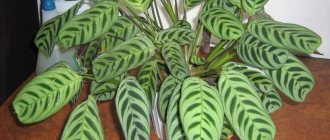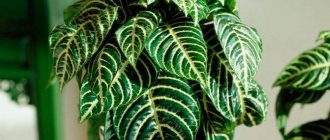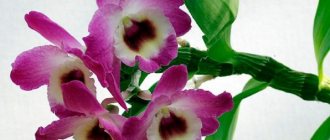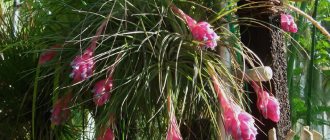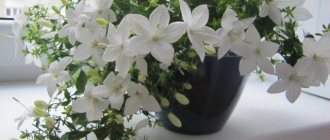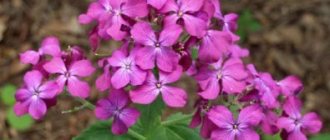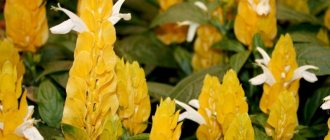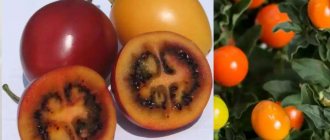Author: Natalya Category: Houseplants Published: February 13, 2019Republished: February 13, 2019Last edits: January 11, 2021
- Growing from seeds
- Why doesn't clivia bloom?
- Clivia gardenii
Usually, the more beautiful the plant, the more capricious it is. But with clivia everything is different: it is beautiful, but not demanding. Clivia received its name in honor of Duchess Charlotte Clive, one of the governesses of Queen Victoria of England. Clivia is a long-liver: given comfortable conditions and proper care, it can decorate your home with flowers for more than forty years! This is surprising, but the older the plant becomes, the more abundantly it blooms, and some specimens are capable of forming several flower stalks at once, twice a year. What types and varieties of clivia are presented in indoor culture, how to create conditions for this plant, how to properly care for it and how to propagate, read our article.
Description of the plant and types of indoor clivias
Clivia is a genus of perennial evergreen herbaceous plants of the amaryllis family (Amaryllidaceae). Botanist John Lindley named the genus in honor of the Duchess of Northumberland Charlotte Clive, governess of the future Queen Victoria of Great Britain. The genus Clivia includes approximately five species of plants in the amaryllis family.
Clivias are evergreen perennial herbaceous plants, stemless, multi-flowered. The leaves are vaginal, tightly covering each other, forming a false stem, linear or xiphoid. Under the ground, clivia develops a rhizome, to which thickened leaf bases and the leaves themselves are attached. Clivia is sort of in the middle between bulbous and rhizomatous plants. The flowers are bell-shaped, red or orange, collected in an umbrella.
One of the most common is Clivia miniata - lat. miniatus - painted with cinnabar, covered with red paint from lat. minium - cinnabar or red lead. In greenhouse and indoor culture it is used as a flower- and foliage-decorative potted plant. The plant's homeland is South Africa.
In the literature it is found under Russian names: orange clivia (matte red, meerkotsvetnaya, red lead), or kaffir (Cape).
Clivias have long been considered outdated and strictly greenhouse plants, but today they are again gaining popularity in indoor culture. This is one of the most original plants among beautifully flowering indoor plants and one of the most striking exotics.
Also known as the kaffir lily , members of the Amaryllis clivia family are the subject of much controversy. This plant is literally overgrown with myths. Even whether clivias belong to rhizomatous perennials or bulbous plants is disputed.
Clivia blooms every year if it is properly watered and not left in a warm room for the winter.
Clivias have a thickened, shortened rhizome, reminiscent of a daylily and do not form bulbs. Species of clivia reach a height of 80 cm, modern varieties and hybrids are much more compact.
The leaves, arranged in two rows, are belt-shaped or paddle-shaped, rather long and wide, forming false stems. With a length of up to 60 cm, clivia leaves are reminiscent of daylilies. But, thanks to the rich color and density, which gives the leaves a slight arched bend, they win in comparison. The plants have a very impressive glossy shine. The bright, cheerful orange inflorescences of clivia, set off by shiny dark green foliage, are extremely beautiful. Clivia flowers bloom in winter. Currently, various varieties of clivia have been bred: from light ocher to dark red flowers with a whole range of warm orange and yellow tones.
Clivias can surprise you with many things, but first of all with their durability. Clivia, in the right growing conditions, can last for 40 years or more!
Despite the classic flowering period from late February to May, clivia often blooms a little later, in March. On strong, powerful peduncles, umbrellas of inflorescences rise above the leaves. Young clivias produce one or several flower stalks, but old, overgrown plants, especially after the first decade, can produce fifty flower stalks per season.
Clivia umbrella inflorescences contain up to 60 large funnel-shaped flowers. Delicate bells are very elegant. After flowering, large berry-like fruits are formed.
The yellow-orange hues of clivia flowers are reminiscent of summer fruits. Cream, apricot, melon, pinkish-peach, cinnabar-pink clivias always look sunny and dazzlingly bright.
Clivias are poisonous indoor plants that require skin protection from any contact with juice when working.
Botanical description
Clivia is a perennial plant that belongs to the Amaryllis family and grows in the subtropical part of South Africa. Adult specimens can reach 60 cm in height , producing up to 6 leaves per year.
Main characteristics:
- the underground part of the flower is represented by a rhizome resembling a bulb;
- Clivia leaves are thickened, have a dense structure and dark green color;
- during flowering, a massive umbrella is formed on the plant, including up to 60 flowers;
- each inflorescence is crowned with 10-20 bells;
- The culture is characterized by tubular or funnel-shaped flowers, the color of which varies depending on the variety - they can be bright yellow, orange, pink-yellow or red-orange;
- After flowering, clivia produces fruits in the form of berries, from which seeds are subsequently extracted.
Flowering usually occurs in February-March , and with proper care it can repeat once more.
Unlike other plants of the Amaryllis family, clivia does not have a bulb. Instead, the flower has a powerful root, which contains all the nutrients.
Types of indoor clivias
Clivia cinnabar, or orange Clivia (Clivia miniata) is the most common and colorful type of clivia. The belt-shaped leaves with a very dark shade of color amaze with their beauty. But this species is valued for its flowering - massive yellow, orange or light red inflorescences of large flowers.
It lives in shady places, from the coast rising into the mountains to an altitude of 600-800 m above sea level, in Natal (South Africa). Plants up to 50 cm tall. The leaves are xiphoid, widened at the base, tapering at the apex, 45-60 cm long and 3.5-6 cm wide. Peduncle 40-50 cm tall, with 10-20 flowers. The flowers are large, on pedicels 2.5-3 cm long, scarlet or red lead, funnel-shaped, with a yellow throat; petals are 4-5 cm long. It blooms in February-May, less often at other times of the year.
There are a number of varieties of Clivia cinnabar, differing in flower color, leaf size and plant height.
Clivia cinnabar, or orange Clivia (Clivia miniata).
Clivia nobilis.
Clivia nobilis differs only in its elongated tubular drooping flowers, predominantly pink in color.
The homeland of the species is the Cape Province (South Africa). Plants 30 cm tall and above. The leaves are xiphoid, tapering at the apex, 4-6 cm wide, with sharp edges. Peduncle 30-50 cm tall, with 40-60 flowers; pedicels up to 3 cm long. Perianth curved; flowers are funnel-shaped, pale red; petals with a green pointed tip, about 2 cm long.
Clivia gardenii. Grows in shady places in the foothills of the Transvaal, Natal (South Africa). Plants up to 50 cm tall. The leaves are xiphoid, 2.5-4 cm wide, tapering at the apex. Peduncle up to 45 cm tall, bears 10-16 flowers. The flowers are narrow, unevenly bell-shaped; petals oblanceolate, 3-3.2 cm long. Blooms in winter.
Reviews from flower growers
My flower calmly tolerates all changes, although I read that he does not like to be moved. I water like everyone else - once a week in winter, twice a week in summer. I try not to overfill. Universal fertilizer. Periodically you need to wipe the leaves from dust. Not only because the plant looks ugly, but also because it is harmful for it. You can sometimes spray, but this is not important. My mother and I have clivias that live for 5-6 years, mine has been blooming for 3 years, but for some reason it still hasn’t for her. This is a mystery to us.
Bastet
https://citykey.net/review/kliviya-krasivyy-komnatnyy-tsvetok
...Clivia is an almost problem-free flower! Clivia can bloom with yellow-white, bright orange or red flowers, somewhat reminiscent of bells. And these flowers are not single, but are in inflorescences, often there are about thirty flowers at once! Extraordinary beauty! This plant does not require moisture, only sometimes I spray its leaves and wipe them to remove dust. But when clivia blooms, it is better not to move or rotate the pot with it at all. And replanting should only be done when the roots are visible from the drainage holes below.
Murmur
https://spasibovsem.ru/responses/tsvetok-s-krotkim-nravom.html
Hello, my dear flower lovers! The other day my orange beauty Clivia blossomed. She is so bright and sunny! Twice a year it pleases me with its flowering. She “lives” on the balcony. Only in the hot summer months do I bring it into the room and place it on the windowsill.
irulchik
https://myfl.ru/category/nazvanie-rasteniya/kliviya-0
They gave me this flower for my birthday (7 years ago). I generally love flowers, but this one immediately sank into my soul, thanks to its stunning flowers. Over the years, I have independently determined how to properly care for him, since there are some subtleties in this. So, tips for caring for clivia: 1) It likes watering only when the soil dries out... 2) When a peduncle appears, it is advisable to water it a couple of times with warm water (about +40 +50 degrees) - this will help the peduncle grow higher and rise above sheets. 3) After it flowers, wait 2-3 weeks and cut off the peduncle - this is important!!! - replant the flower. Take it out of the pot, cut off the roots a little (I cut it with a knife)... If you do this, I guarantee that your flower will bloom for the second time in a year! 4) Location - east window only. On other sides of the world it grows worse and may not bloom at all. Flowering, by the way, lasts almost 20–25 days. For me - once every six months. And he also gives children. Definitely recommend!
vergo
https://irecommend.ru/content/moe-oranzhevoe-chudo-0
Conditions for growing clivia at home
Clivia does not fully bloom without a cool winter. The remaining requirements for conditions should also not be ignored: Clivia prefers stability in everything and does not like to be touched again.
Lighting and placement of clivia
Clivia is light-loving and will not bloom normally in shade. But the plant does not tolerate direct sunlight, especially in summer. Clivia is placed in places with diffused lighting, near windows, but not necessarily on window sills.
When choosing a place for clivia, you need to rely on consistency: clivia cannot tolerate even small changes and “restlessness”. It is not recommended to even slightly move the pot with the plant, and moving it to a new place can even cause considerable problems. Clivia does not like unnecessary touches, too frequent “grazing”, turning and crowding: the leaves of the plant should not touch walls, windows or surfaces.
Temperature and ventilation
Clivia prefers cool weather; it should spend the winter indoors with air temperatures no higher than 15 degrees. The ideal temperature range for the dormant period is from 8 to 12 degrees Celsius (from September to January). But even in summer it does not tolerate the heat well. Temperatures between 16 and 20 degrees are the best option.
In summer, clivia can be taken out into the fresh air, placed in partial shade and shade. And even in winter, rooms should be ventilated regularly. If there is no temperature difference, clivia tolerates light drafts quite well.
Rules of care
There are several basic rules for the care and maintenance of the plant. If you follow these instructions, flowering will occur on time and will last about a month:
- lighting. The best option is diffused light. Try to find a place for the flower on the east or west side. In summer, keep the flower outdoors;
- temperature regime. In the warm season: 20-25°C, in autumn – 14-15°C. When the temperature increases or decreases, the plant may stop developing;
- water with soft water. Clean up excess water that has flowed down. It is not necessary to spray the foliage; it is better to wipe it occasionally to remove dust and dirt;
- do not forget to fertilize the soil;
- watch for the appearance of pests on the flower;
- do not disturb the rest period. The older the flower, the longer it needs rest. For perennial plants it can reach 5 months, for young plants – 2-3 months.
These rules will help preserve Clivia for a long time. Proper care will ensure that it blooms a second time.
How to get clivia to bloom regularly?
To achieve regular flowering, it is necessary to provide clivia with a period of rest. For young plants it should last two months starting from October-November. The larger the plant, the longer the dormancy. From September, watering is stopped completely. However, make sure that the plants do not begin to shed their leaves. Then the clivia needs to be watered lightly.
With the appearance of the flower arrow, the clivia is transferred to a warm place, watering is increased and fertilized. But at the same time, we must remember that clivia can be transferred to a warm place and watered abundantly only when the arrow grows to 10-15 cm.
Clivia does not like waterlogging, languishes in the shade, but does not tolerate direct sunlight.
Clivia does not tolerate disturbance: do not move the pot during the period of bud setting or flowering. After any movement, the pot with the plant should be placed in the previous direction of growth, this can prevent the leaves from falling. During the growing season, the plant can form 5-10 new leaves.
Clivia blooms most often begin in February. Under normal conditions, the flowering period of an individual specimen can stretch up to 3-4 weeks, since the flowers in the inflorescence bloom gradually. There can be up to 30 flowers on one peduncle. If you use artificial pollination, you can get large fruits with seeds: first green, and then, after almost a year, orange-red. They also decorate the plant. However, fruiting greatly depletes clivia and it is not advisable to preserve the fruits on the plant without the need; it is better to cut off the ovaries. But if you still want to collect the seeds, the fruits must ripen and become soft.
Features of cultivation
The indoor clivia flower is a stemless evergreen plant with dark green elastic sword-shaped leaves from 40 to 75 cm long and 5.5 to 8 cm wide. The basal leaves of clivia, forming a rosette, tightly cover each other, forming a false stem. The peduncle, ribbed along the edges, of which one plant can have several, reaches a height of 20 to 40 cm, on which an umbrella-shaped inflorescence is formed of 12-30 bell-shaped flowers with a diameter of 15 to 20 cm, which bloom gradually, so the flowering of clivia lasts up to three weeks . The fruit of clivia is a berry.
- Names of indoor plants
In home floriculture, Clivia cinnabar (Clivia miniata) and Clivia beautiful (Clivia nobilis) are most often grown. What distinguishes the clivia plant from other amaryllis and other indoor flowers?
- Clivia is a kind of transitional plant from bulbous to rhizomatous. It has a short, succulent rhizome with thick, fleshy roots.
- All parts of clivia are used in pharmacology, but it should be remembered that the roots and leaves of clivia are toxic because they contain lycorin, which causes increased salivation, vomiting, and even paralysis in large doses, so be careful when replanting the plant and warn your family about these properties of clivia.
- At home, clivia needs a period of rest in a cool room, but if the rules for caring for the plant are followed and it is comfortable in your place, then in adulthood clivia can bloom even twice a year.
- Clivia does not tolerate disturbance: do not move or move the pot during flowering or bud formation, and do not replant the plant until the roots begin to crawl out of the drainage hole.
Caring for clivia at home
Bright, diffused light is suitable for clivia; the plant is shaded from direct sun. Suitable for placement near windows with western and eastern exposure. Near southern exposure windows, the plant should be shaded from direct sunlight. On a north window, with insufficient lighting, clivia grows more slowly and may not bloom. The plant can spend the summer outdoors in partial shade.
The optimal temperature for clivia in the spring-summer period is around +20.. +25 °C, from October the temperature is reduced to +12.. +14 °C, when the plant begins to produce a peduncle, the temperature is increased to +18.. +20 °C. Clivia can tolerate high temperatures during the dormant period, but this does not have a very good effect on the well-being of the plant and its subsequent flowering.
Watering and air humidity
It is not for nothing that watering is considered the key to the annual abundant flowering of clivia. Without the correct stable soil moisture, clivia will be capricious and bloom sparingly, and without changing the schedule and method of watering, even a cool winter will not be possible.
Watering for clivia should correspond to the stage of plant development. From the moment the peduncle reaches 15 cm in height until autumn, clivia is watered abundantly and often. They do not allow dampness, but maintain stable humidity with the drying of the top layer of the substrate.
But from autumn until the moment when the peduncle begins to grow, clivias in the cool season do not need to be watered at all. If the air temperature exceeds optimal values, water the clivia very carefully and rarely. During the dormant period, it needs light moisture; you can simply spray the plant with a spray bottle to lightly moisten the soil and leaves.
To flower, the plant requires proper care.
The higher the temperature, the more watering is increased, still allowing the substrate to dry out to a third of the depth. As soon as the peduncle grows to 15 cm, the clivia begins to be watered abundantly again, without smooth transitions. The water temperature for clivia should be slightly warmer than the air in the room. Water should not be left in the trays even for a few minutes.
Clivia does not like only very dry air, the proximity of heating devices or air conditioners. She is quite content with sprays that maintain average performance and does not need humidifiers.
It is better to keep clivia leaves clean by carefully wiping off the dust with a damp sponge. Too often and aggressively the clivia is not wiped off, reducing the procedures to the minimum possible.
Top dressing and fertilizer composition
Clivia responds positively to fertilization. From the first year of the crop, starting from the first picking, liquid organic and complete mineral fertilizer (2 g per 1 liter of water) is applied annually from spring to August, every 2 weeks, alternately. For clivia, fertilizing is needed in half-reduced doses once a week during the period of peduncle growth (starting from 2-3 weeks after the resumption of watering) until flowering. After flowering until September, fertilizing is done as standard - once every 2-3 weeks. For this plant, you can only use fertilizers for flowering crops.
If you do not know how to artificially pollinate clivia or you do not need seeds, then you need to cut off the shoot after flowering.
Pruning and replanting
Pruning comes down to removing the peduncle. It does not tolerate leaf pruning well, with the exception of wilted greenery.
Clivias do not like frequent transplants. Only for the first few years the plant is replanted annually or every two years, as the space in the pot is filled. Adult clivias are replanted once every 3-4 years, slightly increasing the capacity. When the maximum size of the containers is reached, clivia is not replanted. Simply replace the top layer of soil twice a year or at least in the spring and make fertilizing more intense.
On a note! Clivia roots do not tolerate transplantation well. They are juicy, fleshy, and serve as a reservoir of water and nutrients. Broken roots can easily rot, especially with excessive watering - when replanting, treat damaged roots with crushed coal or ash.
This plant prefers not very tall, cramped containers. Since clivias are massive, grow in large groups, and their inflorescences are heavy, they need to be grown in very stable containers or with heavy drainage. Ceramic pots are ideal for clivia. The pots for clivia are small so that the plants barely fit, then they bloom more abundantly and longer.
Clivia requires loose, slightly acidic (pH about 6) soil made from turf soil (2 parts), humus (1 part) and peat (1 part). These plants will prefer nutritious, clayey, coarse substrates - special soils for Amaryllis.
Clivias will do well with any other loose, slightly acidic soil mixture. It is useful to add a little superphosphate or other slow-acting phosphorus fertilizers to the mixture (at the rate of 2 tablespoons per 3 liters of mixture). The bottom of the pot provides good drainage. Clivia is an excellent hydroponic crop.
Transplanting a plant
Clivia is one of the plants that does not like unnecessary disturbance. Therefore, its transplantation is carried out only when necessary. Adult plants are transplanted when the roots protrude strongly from the surface. This is approximately once every two to three years. Young flowers can be replanted annually. Plants older than ten years are not recommended to be replanted, only to renew the top layer of soil.
Pot suitable for Clivia
When choosing a pot, you need to remember a couple of nuances:
- Do not take a pot with a much larger diameter, otherwise you will have to wait several years for flowering until the roots fill the space of the pot. The pot is selected two to three centimeters larger than the previous one (in diameter).
- The pot should be in the shape of a cylinder, without narrowing downwards. This is due to the characteristics of the rhizome, which grows downwards and not outwards.
The plant can be replanted only after the end of the flowering period. When transplanting, the transshipment method is used to minimize trauma to the rhizome. If the transplant is carried out with the separation of children, then the incision sites must be sprinkled with powdered activated carbon and dried in air.
Be sure to add about two centimeters of drainage to the bottom of the new pot. For drainage, you can use expanded clay, pebbles, and small pieces of brick. A small layer of earth is poured onto the drainage. Clivia roots are carefully placed on top and gently sprinkled with soil. Care must be taken not to cover the growing point from which the leaves emerge. It is better if it rises slightly above the soil.
As a soil, you need to choose a light, loose mixture with a slightly acidic reaction. When making your own soil, it is recommended to take soil from the garden, peat and sand in a ratio of 2:1:1. To loosen the soil, you can add charcoal, vermiculite, and crushed tree bark. You can purchase a ready-made mixture at flower shops. For clivia, ready-made soil for orchids is suitable, in which the plant feels great.
Before use, it is recommended to disinfect the earth mixture from possible larvae or bacteria. To do this, place it in the microwave for two to three minutes at full power or in a preheated oven for ten minutes.
This may be interesting: Types and varieties of indoor Bougainvillea
Clivia propagation methods
The main method of propagating clivia is simple division. Clivias grow so much that with each transplant, old plants can be divided into 2-3 parts or individual daughter rosettes can be separated.
It is not easy to grow clivia from seeds, and you will have to wait at least 5 years for the first flowering. Sow freshly harvested clivia seeds in light soil, lightly covering with a layer of sand. Under film or glass, at a temperature of about 23 degrees, seedlings appear unevenly and slowly. Seedlings are very fragile during the first year and require repeated picking.
Rules and regulations
Conditions (temperature, humidity)
Clivia is not picky about humidity parameters, but the optimal temperature for the event would be the usual room temperature of 20-25 degrees.
Preparing for transplant
Drainage
Place a drainage layer of expanded clay granules, small pebbles or crushed stone, and small fragments of red brick at the bottom of the pot. This is necessary to regulate soil moisture.
Disinfection
The need for action is caused by the probable presence in the soil of harmful bacteria and larvae of parasitic insects that cause diseases in plants (read about the causes of clivia diseases and methods of treating them here). There are four ways to disinfect soil.
The first is when the soil is spilled with boiling water. The second is when they are treated with a solution with a minimum percentage of potassium permanganate. Third - the soil is heated in the oven at 250 degrees for ten minutes. The fourth method is calcination in the microwave for three minutes at maximum temperature.
Sometimes they resort to the use of chemicals for the purpose of antiseptic treatment , but they not only destroy harmful factors, they also disrupt the healthy microflora of the soil.
Fertilizers
After the antiseptic part, the soil is enriched with nutritious fertilizers.
Recommendation! Traditionally, phosphorus-containing compounds are used for clivia, such as superphosphates or phosphate rock. They put on average thirty grams.
For young seedlings, loose soil is more suitable; for this reason, perlite or sand is mixed into the soil at the rate of one part of the product to five parts of soil.
Clivia propagation by seeds
The period from pollination of flowers to the ripening of clivia fruits lasts 9-10 months; Each fruit contains many seeds. Seeds are sown soon after ripening (usually in November-April). The composition of the earthen mixture is as follows: turf - 1 tsp, peat - 0.5 tsp, sand - 1 tsp. Clivia seeds are placed in a sowing container at a distance of 2x2 cm. Shoots appear in 4-6 weeks; After the formation of the first leaf, the plants are planted in 7-centimeter pots. In 5-6 months, plants form 4-5 leaves.
Clivia seeds.
Sprouted Clivia seeds.
In the second year, young plants are transferred to 9-10 cm pots, and in the third year - into 12-13 cm ones. Recommended substrate: turf - 2 hours, humus, peat and sand - 1 hour each.
Plants grow slowly - in the second year they form 3-4 pairs of leaves and subsequently produce 2 pairs of new ones. In the third year, starting in September, clivias are kept in a dry state (rest period) for about 2 months. After such care, about 30% of clivia seedlings bloom: unflowered plants continue to be kept in the same conditions as in the previous year, providing a dormant period from September, lasting 2 months. In the fourth year of cultivation in winter, the plants are kept at a temperature of 10-12 °C until the top of the peduncle appears. From this time on, begin abundant watering and spraying of plants, and the temperature is raised to 18-20 °C.
Vegetative propagation of clivia
In indoor conditions, it is better to propagate clivia by offspring, which are separated from adult plants during transplantation. It must be remembered that clivia has very fragile roots, so they should not be damaged during planting and replanting; they rot easily. The shoots must have at least 4 leaves. They are separated after flowering and planted for rooting in 7-centimeter pots in sand at a temperature of 16-18 °C. Watering should be moderate, as young plants can easily rot from excess moisture.
Rooted clivia shoots are transplanted into a mixture of leaf, greenhouse, and turf soil (1:1:1).
Note! Clivia leaves are poisonous and can cause vomiting, diarrhea, and collapse.
Toxicity and beneficial properties
Despite its external beauty, clivia is considered a poisonous plant. If the root part and leaves are damaged, yellowish discharge can be detected - these are alkaloids , dangerous and toxic substances.
Their entry into the human body causes paralysis and even death. In this regard, the culture must be placed on window sills or in other places in such a way that small children or pets cannot reach it.
Important! After flower care procedures, you must wash your hands thoroughly with soap.
In addition to alkaloids, clivia juice contains substances such as lycorin and clivatin , which allows the culture to be used in pharmacology. Raw materials from this plant are used to make various medicines that improve blood circulation.
Diseases and pests of clivia
Indoor clivias suffer only from dampness and rotting due to stagnation of water at the bottom of the soil. In the vicinity of infected plants, scale insects and felt insects quickly spread to them.
Scale insects are the most common pests of clivia - brown plaques on the surface of leaves and stems that suck out cell sap. The leaves lose color, dry out and fall off.
Control measures . To mechanically clean pests, the leaves are wiped with a soapy sponge. Then the plant should be sprayed with a 0.15% Actellik solution (1-2 ml per liter of water).
Mealybugs : They affect leaves, shoots, and, if present, flowers. The leaves become bent, dry out and fall off, and the plant dies.
Control measures . Wipe the plant with a soapy sponge and wash in a warm shower. In case of very severe damage, the plant can be sprayed with a 0.15% Actellik solution (1-2 ml per liter of water).
Due to waterlogging of plants, browning of the tips of the leaves and even rotting of the base of the stems and roots can occur.
Due to low temperatures or lack of moisture during the growth period, the peduncle may be short .
Plants can get sunburn from direct sunlight, causing white spots to appear on the leaves .
The absence of peduncle shoots and faded leaves of the plant may indicate insufficient feeding.
If the dormancy period is too short, the room temperature is high, or the light level is low, the plant may not produce flowers .
How to make it bloom
Many housewives are trying to understand why clivia does not bloom. This is mainly due to transplanting the plant into a large flowerpot. In this case, the culture will actively form roots.
Only after the earthen coma is filled will the first inflorescences begin to form. Lack of flowering is also associated with a deficiency of nutrients in the soil or lack of proper lighting.
You can make a plant bloom as follows:
- To form flower buds, increase the dormant period.
- During flowering, set the room temperature within +13...+16 degrees. The plant should receive diffused color in the required quantity.
- Feed the plant with liquid solutions of organic matter or potassium fertilizer.
Important! With proper care of the crop, you will never have to wonder how to make clivia bloom.
